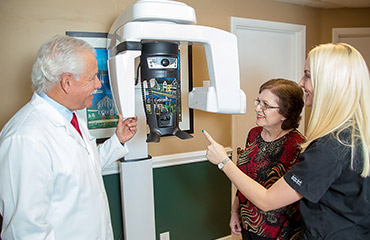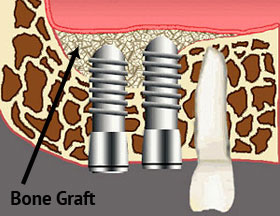Treatment for Dental Implant Problems in Tamarac

Skilled Treatment of Implant Complications
- Signs of Dental Implant Problems
- Causes of Dental Implant Problems
- Treatment for Dental Implant Problems
We occasionally see new patients who received dental implants in the past and are now having problems with them. Although the vast majority of implant placements are successful, a small percentage of implants can develop infection or other problems which need special treatment. Dr. Levine uses advanced diagnostics and minimally invasive treatment to restore compromised implants to full stability.
Skilled Implant Specialist

Dr. Levine is a highly skilled specialist in treating any problems with implants.
As a periodontist, Dr. Levine is a highly trained and experienced specialist in the placement and follow-up care of dental implants. He will diagnose and treat any problems that might occur with them.
In addition to his periodontist training, Dr. Levine has earned extensive postgraduate certifications from several of the leading implant training institutes in the United States.
Dr. Levine taught periodontics at three different Florida universities. He currently teaches implant dentistry and other periodontal procedures to dentists in Florida as a continuing education instructor.
Signs of Dental Implant Problems
The following symptoms indicate your implant has developed complications. If you experience any of these symptoms, you should come in for a full examination as soon as possible:
- The gums are swollen around the implant
- The gums around the implant are red or a blue-purple color, which is evidence of inflammation
- The gums around the implant bleed at the gum line when brushing
- The area around the implant is sensitive or painful
- Pus is coming from the area around the implant
- The threads of the implant post are visible
- The implant is loose
Causes of Dental Implant Problems
When implant complications occur, the most common sources of difficulty or failure are as follows:
Placement failure
Implants placed in the wrong position or where the bone support is inadequate can become unstable. Normal biting forces on an insufficiently supported implant can cause the implant to become loose or even fall out. Unstable implants are also more susceptible to infection.
There are rare instances where an implant was placed in the correct position, but the bone failed to integrate with the implant so as to secure it firmly in the jaw. This will cause the same consequences as a wrongly positioned implant.
Infection around the implant
 Most implant infections take the form of a special type of gum disease known as peri-implantitis. Peri-implantitis is considered to have developed when there is gum infection and bone loss around an implant.
Most implant infections take the form of a special type of gum disease known as peri-implantitis. Peri-implantitis is considered to have developed when there is gum infection and bone loss around an implant.
Peri-implantitis can be caused by a number of factors, including poor oral hygiene, smoking, and major health problems such as diabetes. Sometimes it is the result of a bite misalignment. When the implant crown is hitting too hard against the teeth in the opposing arch, the implant becomes destabilized and therefore susceptible to infection. Left untreated, infection and continuing bone loss can lead to implant failure.
Restoration placed too soon
Crowns, bridges or dentures should only be placed on implants that are stable enough to support the load. If a restoration is placed before the implants can easily manage the biting and chewing pressure, the implants can become destabilized or even fail.
Treatment for Dental Implant Problems
Dr. Levine will use state-of-the-art diagnostic tools to determine the exact trouble with a compromised implant. He then executes a customized plan of advanced, minimally invasive procedures that are highly effective in restoring the implant.
Thorough diagnostics

When needed, Dr. Levine uses our advanced 3D CT scanner to get to the bottom of implant problems.
Dr. Levine conducts a full examination to assess the extent of any infection or instability. He will take any needed X-rays and a 3D CT scan, if necessary.
From the X-rays and CT scan, Dr. Levine will determine the extent of any bone loss around the implant. He will be able to see if the problem extends further than the location of the implant itself. He will examine your bite to see if the implant-supported tooth is experiencing excessive bite forces when it meets the teeth in your opposing arch.
Laser treatment to eliminate infection
If the implant site is affected by peri-implantitis, Dr. Levine uses a dental laser to disinfect the area around the implant and remove diseased tissue. Laser disinfection is highly effective and removes the need for traditional gum disease surgery.
Antibiotic therapy
We often use antibiotics as a second line of attack against the infection. Dr. Levine either places antibiotic microspheres onto the tissues themselves or prescribes appropriate medication to take orally.
Bone grafting to replace lost bone
 When needed, Dr. Levine will place a bone graft to regenerate lost bone and rebuild support for the implant.
When needed, Dr. Levine will place a bone graft to regenerate lost bone and rebuild support for the implant.
Building back the gum line with gum grafting
If there is inadequate gum tissue around the implant, Dr. Levine will perform a minimally invasive gum grafting procedure to rebuild the necessary support.
Low-level laser therapy to stimulate healing and reduce discomfort
Dr. Levine uses a dental laser to perform low-level laser therapy on all the treated tissues at the end of your procedure. Laser energy helps stimulate healing while reducing swelling and discomfort.
Replacing a failed implant
If an implant is too compromised to be saved, Dr. Levine removes the implant and replaces it with a new one. If replacement is necessary, he will thoroughly explain the treatment needed for a new implant and he will answer all of your questions.
To make an appointment, call 954‑722‑1100 or click here to request an appointment online.
